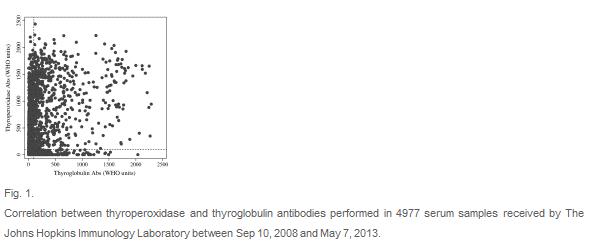Note that this description identifies antibodies being used for diagnosis but "hematopoietic mononuclear cells, mainly lymphocytes" as the actual agents that infiltrate the thyroid.
Review
Hashimoto thyroiditis: Clinical and diagnostic criteria
P. Catureglia, b, Corresponding author contact information, E-mail the corresponding author,
A. De Remigisa,
N.R. Rosea, b
a Department of Pathology, The Johns Hopkins University School of Medicine, Baltimore, MD, United States
b Feinstone Department of Molecular Microbiology and Immunology, The Johns Hopkins Bloomberg School of Public Health, Baltimore, MD, United States
Abstract
Hashimoto thyroiditis (HT), now considered the most common autoimmune disease, was described over a century ago as a pronounced lymphoid goiter affecting predominantly women. In addition to this classic form, several other clinico-pathologic entities are now included under the term HT: fibrous variant, IgG4-related variant, juvenile form, Hashitoxicosis, and painless thyroiditis (sporadic or post-partum). All forms are characterized pathologically by the infiltration of hematopoietic mononuclear cells, mainly lymphocytes, in the interstitium among the thyroid follicles, although specific features can be recognized in each variant. Thyroid cells undergo atrophy or transform into a bolder type of follicular cell rich in mitochondria called Hürthle cell. Most HT forms ultimately evolve into hypothyroidism, although at presentation patients can be euthyroid or even hyperthyroid. The diagnosis of HT relies on the demonstration of circulating antibodies to thyroid antigens (mainly thyroperoxidase and thyroglobulin) and reduced echogenicity on thyroid sonogram in a patient with proper clinical features. The treatment remains symptomatic and based on the administration of synthetic thyroid hormones to correct the hypothyroidism as needed. Surgery is performed when the goiter is large enough to cause significant compression of the surrounding cervical structures, or when some areas of the thyroid gland mimic the features of a nodule whose cytology cannot be ascertained as benign. HT remains a complex and ever expanding disease of unknown pathogenesis that awaits prevention or novel forms of treatment.
sciencedirect.com/science/a...
Rod

 *sigh*
*sigh*